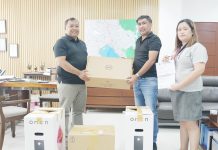TACLOBAN CITY – The Institute for Climate and Sustainable Cities (ICSC), a non-government organization, and residents of sitio Costa Brava in Barangay 88, San Jose in this city conducted an evacuation drill to culminate the observance of National Disaster Resilience Month.
The use of ‘TekPak’, a portable solar-powered kit that can be used for lighting and powering emergency communications and medical equipment highlighted the evacuation drill.
The drill coincided with a power-outage that hit Tacloban that lasted for 14 hours. The participants used TekPak to charge their gadgets like the two-way radio and cellular phone. It was also used to power nebulizer.
TekPak and RE-Serve Humanitarian Corps is one of the 40 innovation supported under the Tuklas Innovation Labs, a program of Plan Philippines in disaster affected areas that encouraging ideas to meet the needs of vulnerable groups.
They are part of the five innovations from Eastern Visayas selected to receive P 1 million in seed funding, training, and mentorship to test their disaster preparedness innovations from March to November 2018.
Just like food and water, access to energy is also important during a disaster as it plays important role in humanitarian response and development both in communication and medical situations said members of RE-Serve Humanitarian Corps.
RE-Serve Humanitarian Corps is a volunteer group composed of respondents from various local government units, humanitarian organization, community groups and students.
The group helped the community by training them on how to use the TekPak.
“Electricity or energization is one of the neglected aspect in disaster preparedness. We in Re-Serve advocates the use of alternative energy in times of disaster once the regular source of electricity backs-down,” Jayson Mendiola, RE-Serve Humanitarian Corps member, said.
“The technology is already here and we can use it by harnessing energy from the sun through solar panels for us to have electricity to charge our mobile phones and other means of communication devices that we can use to relay information in the villages to the municipality,” Mendiola added.
Mendiola added that the ICSC is developing a handier TekPak more lighter than the one they are currently using the TekPAk 4.
“They are coming up with TekPak 5, which is about a size of a first-aid kit box and the solar panel is foldable so our can bring it easy anywhere and anytime,” Mendiola said.
Emelita Montalban, Brgy. 88 chairwoman, said that they were blessed to be selected as the site of the drill and to receive one unit of TekPak from the humanitarian organization.
“Having this TekPak will really help our village by ensuring that our place is lighted and communication will continue because we have source of electricity to power our communication devices even there is no power from regular energy source,” Montalban said.
The entire Brgy. 88 is classified by the City Disaster Risk Reduction and Management Office as a danger zone due to its location sandwich between Cancabato Bay and San Pedro Bay.
When Tacloban City was pummelled by super typhoon ‘Yolanda’ on November 8, 2013, San Jose was considered as its worst-hit area with most of the 2,200 people killed in Tacloban during the massive disaster were from the said village. (ROEL T. AMAZONA)



